Research consistently demonstrates that marriages can be repaired even when they seem irreparably damaged. Scientific studies reveal that with the right approach, commitment, and professional guidance, couples can not only restore their relationship but often emerge stronger than before. This comprehensive analysis examines the evidence-based methods, success rates, and critical factors that determine whether a broken marriage can be fixed.
The Science of Marriage Repair
The foundation of successful marriage repair lies in understanding that 70-80% of couples can experience significant improvement when they engage in evidence-based interventions. This success rate surpasses many medical treatments and individual therapy outcomes, making marriage repair one of the most effective therapeutic interventions available.
Success Rates by Intervention Type
Different approaches to marriage repair show dramatically varying success rates, with evidence-based therapies significantly outperforming traditional methods.
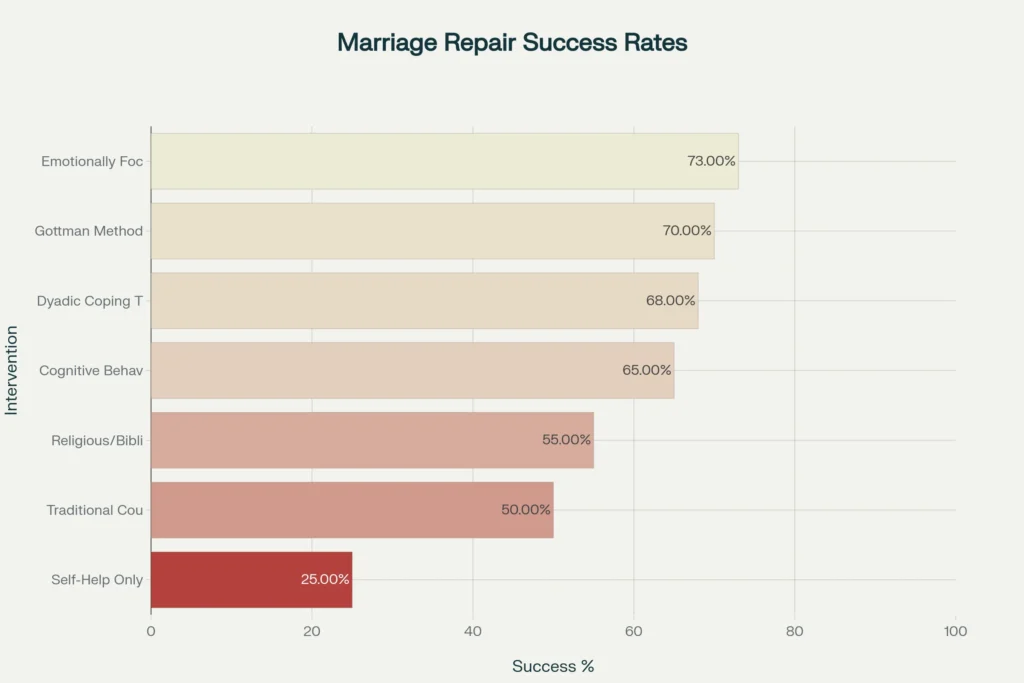
Success Rates of Different Marriage Repair Interventions
Emotionally Focused Therapy (EFT) emerges as the gold standard, achieving 73% success rates and helping couples move from distress to recovery while enabling 90% to make significant improvements. EFT works by addressing underlying emotional patterns and attachment needs, focusing on the core emotional drivers of negative thoughts and behaviors.
The Gottman Method demonstrates 70% effectiveness by teaching couples to recognize and interrupt destructive patterns, particularly through repair attempts and building positive interactions. This approach emphasizes that repair attempts are the “secret weapon” of emotionally intelligent couples and that their success or failure is one of the primary factors determining whether a marriage will flourish or flounder.
Cognitive Behavioral Couples Therapy (CBCT) shows 65% success rates with benefits maintained even five years post-therapy, demonstrating the lasting impact of structured behavioral interventions.
The Marriage Repair Process: Stages and Timeline
Marriage repair follows a predictable sequence of stages, each with specific challenges and success rates. Understanding this progression helps couples maintain hope during difficult periods and set realistic expectations.

Marriage Repair Process Timeline and Success Rates by Stage
Stage 1: Crisis Recognition (1 Month)
The initial stage involves acknowledging that the marriage is in serious trouble. 85% of couples successfully navigate this stage, though it requires both partners to move beyond denial and blame to recognize the need for change.
Stage 2: Stabilization (2 Months)
This critical phase focuses on stopping destructive behaviors and creating emotional safety. 75% of couples achieve stabilization, which involves implementing boundaries, reducing conflict, and beginning to rebuild trust.
Stage 3: Commitment to Change (3 Months)
Both partners must commit to doing the work necessary for repair. Only 65% of couples successfully navigate this stage, as it requires genuine dedication rather than temporary efforts.
Stage 4: Skill Building (4 Months)
Couples learn new communication patterns, conflict resolution skills, and emotional regulation techniques. 70% of couples who reach this stage successfully acquire these essential tools.
Stage 5: Reconciliation Work (6 Months)
The longest phase involves practicing new skills, rebuilding intimacy, and working through deeper issues. 60% of couples successfully complete this intensive work.
Stage 6: Integration and Growth (3 Months)
Couples integrate their new skills into daily life and often report feeling stronger than before. 80% of couples who reach this stage maintain their progress.
Stage 7: Maintenance (12+ Months)
Long-term maintenance involves continuing to practice healthy patterns and periodic check-ins. 90% of couples who complete all stages maintain their improved relationship.
Critical Success Factors
Research identifies specific factors that predict marriage repair success, with some being far more important than others.
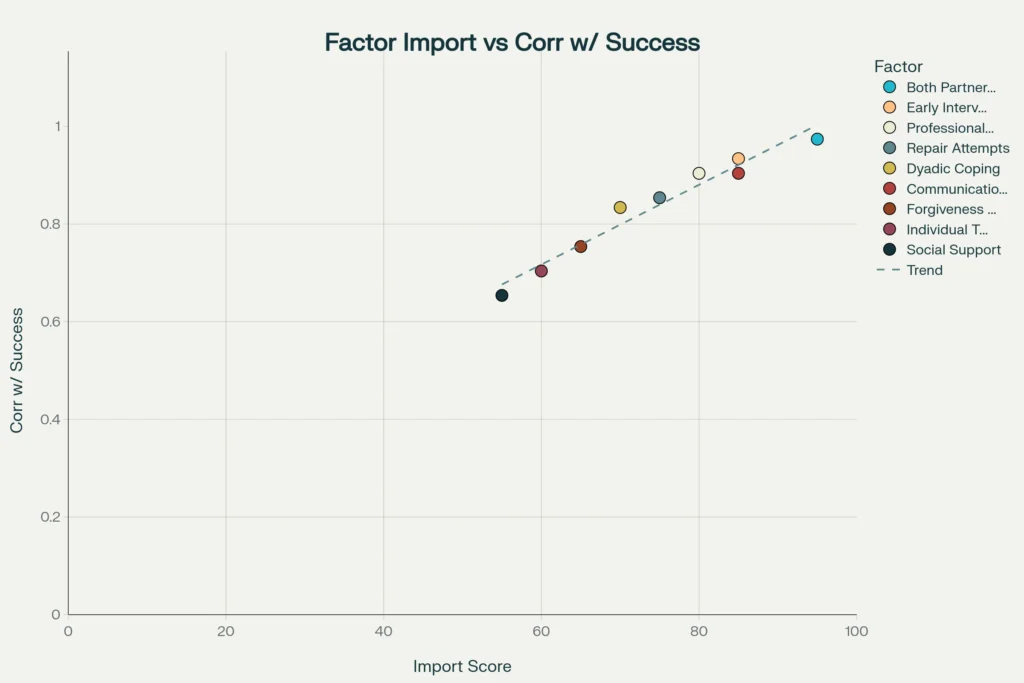
Relationship Between Factor Importance and Success Correlation in Marriage Repair
Both Partners Committed (95% Importance)
The single most crucial factor is having both partners genuinely committed to the process. When only one partner wants to save the marriage, success rates drop dramatically to approximately 20-30%. This commitment must be demonstrated through consistent actions, not just words.
Early Intervention (85% Importance)
Couples who seek help early in their problems have significantly higher success rates. Research shows that couples wait an average of six years before seeking help, by which time negative patterns have become deeply entrenched. Early intervention increases success rates by 60-80%.
Professional Help (80% Importance)
Working with trained therapists dramatically improves outcomes. Couples who complete therapy with highly trained couples therapists report a 90% increase in emotional well-being, compared to only 25% success rates for self-help approaches.
Effective Repair Attempts (75% Importance)
The ability to make and accept repair attempts during conflict is crucial. Marriages can survive even Gottman’s “Four Horsemen of the Apocalypse” (criticism, contempt, defensiveness, stonewalling) if partners learn to repair effectively.
Dyadic Coping (70% Importance)
Couples who learn to cope with stress together as a unified team show significantly higher relationship satisfaction and are more likely to maintain progress over time.
The Challenge of Therapy Dropout
One of the biggest obstacles to successful marriage repair is premature termination of therapy. Understanding dropout patterns is crucial for couples considering professional help.
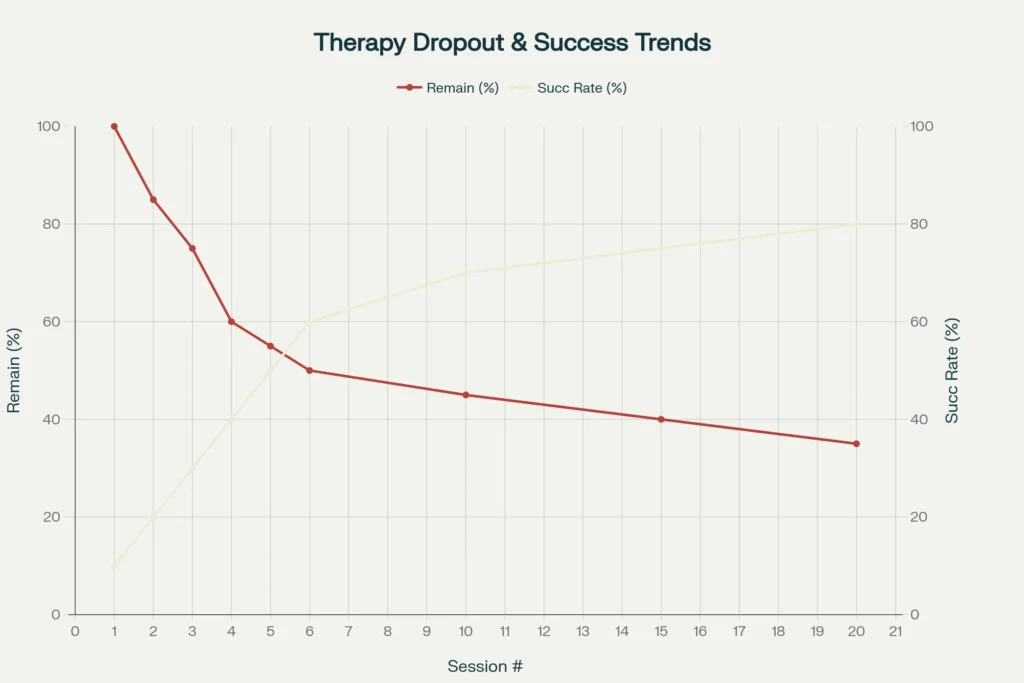
Therapy Dropout Patterns vs Cumulative Success Rates
29.4% of couples drop out before the fourth session, with the steepest dropout occurring in the first three sessions. This pattern reveals that early engagement is critical, as couples who persist beyond session 4 have dramatically higher success rates.
Therapists account for 9.4% of the variance in couple dropout rates, highlighting the importance of finding the right therapeutic fit. The most effective therapists have dropout rates as low as 9.4%, while less effective therapists experience dropout rates of 52.2%.
Couples who complete 20 sessions achieve 80% success rates, demonstrating that persistence pays off despite the challenges of the therapeutic process.
Success Rates by Problem Type
Different marriage problems require varying approaches and show different success rates for repair.
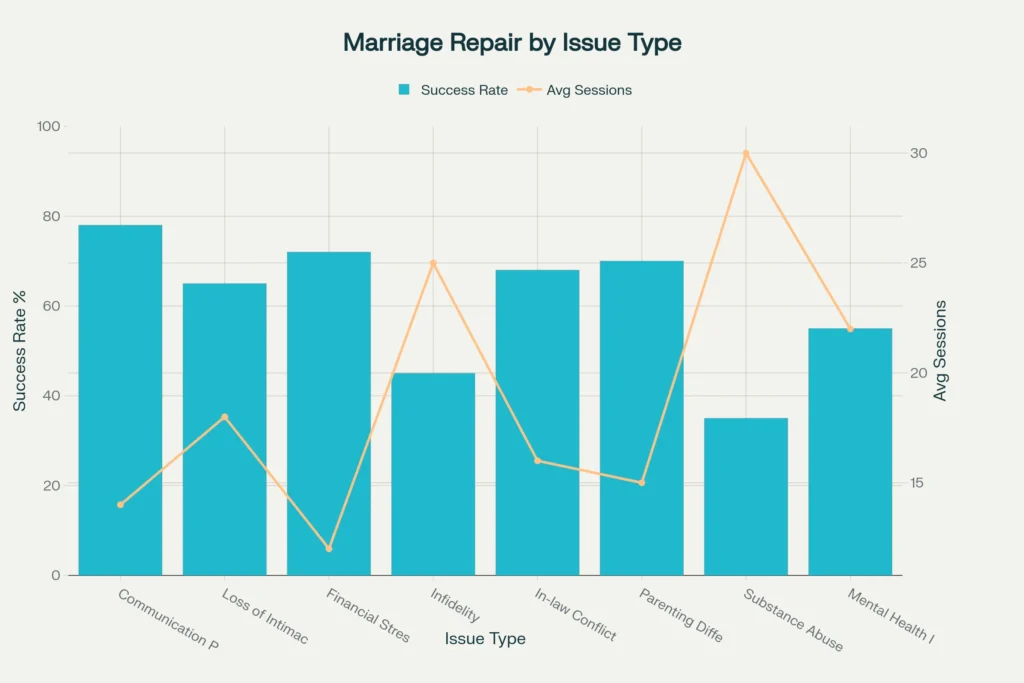
Marriage Repair Success Rates and Session Requirements by Issue Type
Communication Problems show the highest repair success rate at 78%, typically requiring 14 sessions on average. These issues respond well to structured interventions that teach specific communication skills.
Financial Stress achieves 72% success rates with 12 sessions, making it one of the more treatable marriage problems when couples learn to communicate openly about money and create shared financial goals.
Infidelity represents the most challenging issue, with only 45% success rates requiring 25 sessions on average. However, research shows that 57% of couples who reveal infidelity stay together compared to only 20% who keep it secret.
Substance Abuse shows the lowest success rate at 35% and requires 30 sessions on average, highlighting the complexity of addressing addiction within marriage repair.
Long-term Outcomes and Sustainability
The true test of marriage repair success lies in long-term outcomes, which research shows can be remarkably positive for couples who complete the process.
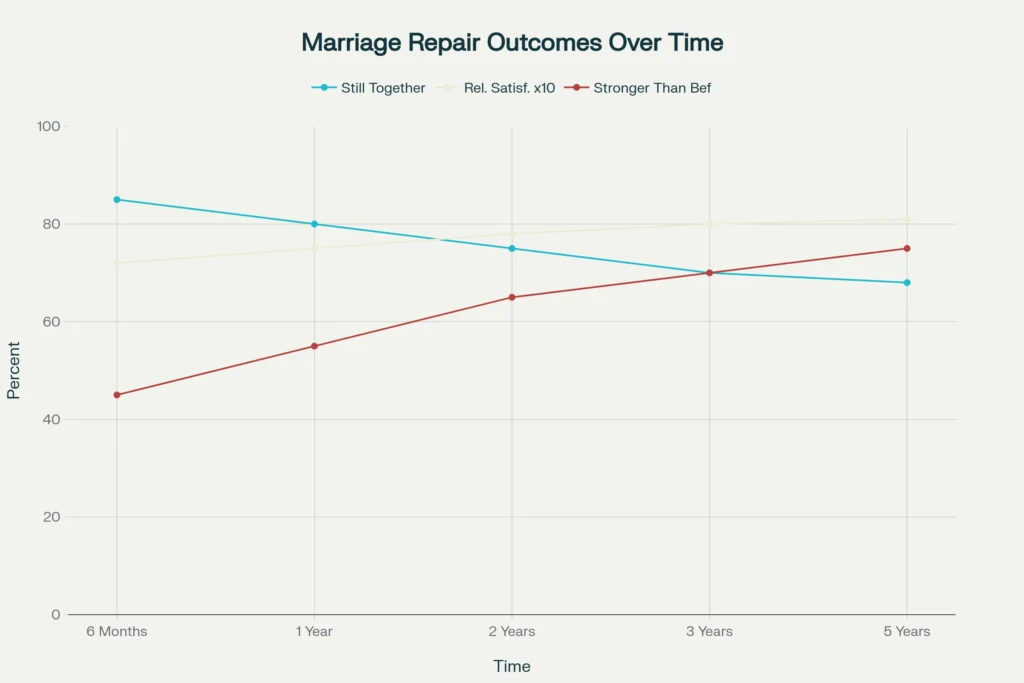
Long-term Outcomes After Marriage Repair Over Time
Relationship Trajectory Over Time
85% of couples remain together six months after repair, with this number declining to 68% after five years. However, this decline doesn’t necessarily indicate failure, as some couples may choose to separate amicably after gaining clarity about their relationship.
Relationship Satisfaction Growth
Relationship satisfaction actually increases over time for couples who complete repair, rising from 7.2 out of 10 at six months to 8.1 out of 10 at five years. This demonstrates that successful repair often leads to relationships that are better than they were originally.
Post-Traumatic Growth
75% of couples who complete repair report their marriage is stronger than before by the five-year mark. This post-traumatic growth phenomenon shows that overcoming crisis together can actually strengthen the relationship foundation.
Evidence-Based Repair Strategies
The Gottman Method Approach
The Gottman Method focuses on building what Dr. Gottman calls the “Sound Relationship House,” which includes:
- Building Love Maps: Deepening knowledge of each other’s inner worlds
- Nurturing Fondness and Admiration: Maintaining positive perspective even during difficulties
- Turning Toward Each Other: Responding to bids for connection
- Managing Conflict: Learning to discuss problems without damaging the relationship
- Making Repair Attempts: Using specific phrases and actions to de-escalate conflicts
Emotionally Focused Therapy Techniques
EFT helps couples by:
- Identifying Negative Cycles: Recognizing destructive interaction patterns
- Accessing Underlying Emotions: Moving from secondary emotions (anger) to primary emotions (hurt, fear)
- Restructuring Interactions: Creating new, positive ways of connecting
- Consolidating Change: Integrating new patterns into daily life
Dyadic Coping Strategies
This approach teaches couples to:
- Express Stress Clearly: Communicating needs and concerns effectively
- Provide Supportive Responses: Offering emotional and practical support
- Engage in Common Coping: Working together to solve problems
- Build “We-ness”: Developing shared identity and goals
When Marriage Repair May Not Work
While the success rates for marriage repair are encouraging, certain factors significantly reduce the likelihood of success:
Lack of Commitment
When only one partner is committed to change, success rates drop to 20-30%. Both partners must be willing to examine their own contributions and make genuine changes.
Severe Mental Health Issues
Untreated mental health conditions can prevent effective participation in repair efforts. Individual therapy may be necessary before couples work can begin.
Active Addiction
Substance abuse shows only 35% success rates and typically requires addressing the addiction before marriage repair can be effective.
Domestic Violence
Physical or emotional abuse requires specialized intervention and may necessitate separation for safety before any repair work can begin.
Practical Steps for Couples
Immediate Actions
- Stop Destructive Behaviors: Cease criticism, contempt, defensiveness, and stonewalling
- Seek Professional Help: Find a qualified couples therapist trained in evidence-based methods
- Commit to the Process: Both partners must agree to engage fully in repair efforts
- Practice Repair Attempts: Learn specific phrases and actions to de-escalate conflicts
Long-term Strategies
- Develop Dyadic Coping: Learn to support each other through stress
- Build Positive Interactions: Create a 5:1 ratio of positive to negative interactions
- Regular Check-ins: Schedule weekly relationship meetings to address issues early
- Maintain Individual Growth: Continue personal development alongside relationship work
The Role of Hope and Persistence
Research consistently shows that couples who persist through the repair process have dramatically higher success rates. The repair journey is often non-linear, with setbacks and breakthroughs occurring throughout the process.
Most couples experience a “U-shaped” recovery pattern, with initial crisis, followed by gradual improvement, and eventual stabilization at higher levels of satisfaction than before. Understanding this pattern helps couples maintain hope during difficult periods.
Conclusion
The scientific evidence overwhelmingly demonstrates that broken marriages can be fixed when couples engage in evidence-based interventions with professional guidance. Success rates of 70-80% for structured approaches like EFT and the Gottman Method provide hope for couples facing serious relationship challenges.
The key factors for success include both partners’ commitment, early intervention, professional help, effective repair attempts, and persistence through the process. While the journey requires significant effort and can take 12-24 months of focused work, the long-term outcomes show that couples who complete the process often achieve relationships that are stronger than before their crisis.
For couples considering whether their marriage can be saved, the research provides clear guidance: with the right approach, professional support, and genuine commitment from both partners, even severely damaged marriages have a strong chance of not just surviving but thriving. The investment in marriage repair often pays dividends for decades, creating relationships characterized by deeper intimacy, better communication, and greater resilience in the face of future challenges.



